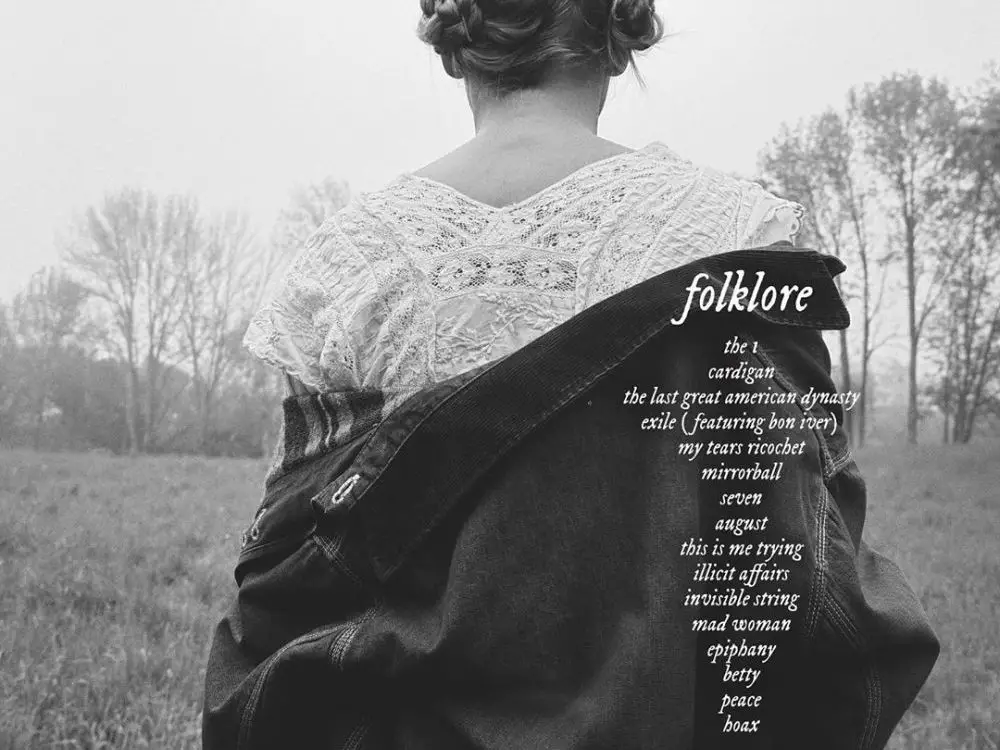On July 23, megastar Taylor Swift announced via an Instagram post that she’d be releasing her eighth studio album, “Folklore,” that night. The announcement came completely out of the blue without any prior advertisements or hints. Sure enough, less than 24 hours later, the album was released to all music streaming platforms. At 11:59, die-hard Swift fans like myself laid awake in a state of anticipatory glee. At midnight, we were transported to the mythical realm of Swift’s “Folklore.”
From the piano chord that opens “The 1” to the final fading notes of “Hoax,” I was completely absorbed in a sonic and lyrical landscape, a picture book without pictures. Each track tells its own story from one perspective, but together, the stories comprise a world.
Folklore: a body of popular myth and beliefs relating to a particular place, activity or group of people.
Correction: These stories comprise a folklore.
For every album, Swift writes her listeners a note that serves as the album’s prologue. The prologue to “Lover” explains that she chooses to be defined by what she loves. In the “Reputation” prologue, she embraces that she is known only by her popular Reputation.
In each note, Swift explains the album’s intentions and reflects on her own writing process, as well as her personal and artistic growth. In this way, Swift bridges the gap between herself and her listeners. The prologues constitute the few moments in which Swift maintains agency over her art before it is whisked away by Rolling Stone critics and Reddit theories.
In the prologue note to “Folklore,” Swift explained, “In isolation, my imagination has run wild, and this album is the result.” The singer writes that she fashioned stories by “escaping into fantasy, history, and memory.” Each song, she explains, constitutes a mythical folklore of her own creation.
[Translation: While we spent the last four months of the pandemic watching TikToks, Swift daydreamed for a while, then wrote and recorded an entire album.]
We can thus understand the album’s 16 tracks as a body of Swift-woven myths about a group of people who are perhaps real, perhaps made up or perhaps somewhere in that gray area between reality and fiction.
Some of the songs are clearly connected. Most blatantly, the tracks “Cardigan,” “August” and “Betty” all tell the story of the same love triangle, but each song is from the perspective of a different corner.
First, in “Cardigan,” Swift gives voice to a girl moving on after a lover has betrayed her. “August,” track eight, is sung by the “other woman” as she processes the heartbreak of her fleeting affair with a boy who was, in her words, “never mine.” Lastly, in the gut-wrenching ballad “Betty,” 17-year-old James stands on his ex-girlfriend’s porch, regretting his affair, ready to beg for forgiveness and dreaming of what could be again.
The triangular narrative is deeply compassionate: Each character is given a voice, a chance to share their own perspective on the events that transpired and lament their pain and longing. We don’t hate any of them for their mistakes; we only feel for their brokenheartedness. Swift’s knack for storytelling is a reflection of her capacity for empathy, an empathy that she projects onto her listeners.
Other songs stand independently. “The Last Great American Dynasty” is a fantastic example of Swift’s pithy construction of legend, as she celebrates the life of her own Rhode Island house before she bought it. Rebekah Harkness, the home’s owner, is a real woman given a second life in Swift’s seductive lore.
“Invisible String” imagines the way fate brought two characters together throughout the course of their lives. “Seven” recalls the world of two 7-year-old best friends separated after childhood. “Exile,” performed with Bon Iver, tells a story of love gone astray from two perspectives simultaneously. “This Is Me Trying” is a wistful moment in the mirror.
In some instances, real-life Swift might embody the song’s perspectives, and in others, she might only be imagining. Either way, they are a part of the album’s lore.
Swift crafts a highly cohesive sonic landscape to ensure that each story lives in the same mythic realm, even when its themes and characters vary. The sounds of the album are ever so slightly compressed, ever so slightly distorted to create a faraway feeling, as if we are watching an old film or speaking through a walkie-talkie. Yes, we are absorbed in the stories of her album, but the faint distortion is a reminder that this reality is not the same one we inhabit; it’s a reality she’s created for us.
That said, the album’s sound is still beautifully immersive. As a listener, I am not ever barraged by a wall of sound, nor am I left with abrasive emptiness. Rather, each instrument flows subtly into the space from its own direction.
Elusive piano phrases run away into lovely fog blankets of mystical-sounding synthesizers. Generous vocal harmonies coat Swift’s hushed melody, then reflect it in soft echo. Gentle drumbeats subtly ground the dreamy music and keep it from floating away entirely. The sonic bliss paints a lush landscape, and it is on this fertile land that the singer’s words grow into stories. Here in this irresistible rapture, stories become folklore.
The overall sound is not a total pivot for Swift, given some of the gentler tracks of “Lover,” but “Folklore” is definitely a step deeper into indie territory than she’s previously traveled. In fact, Swift collaborated with Aaron Dessner of The National on 11 of her songs.
Though each of Swift’s individual albums might fit into a neat musical style, from a bird’s eye view, Swift’s career cannot be cleanly mapped by genre. Swift began her career with two feet planted firmly in country pop territory but since then has leapfrogged around, experimenting with stadium rock, electro-pop, dream pop and even hip-hop.
The album’s headfirst dive into the indie genre should come as no surprise: Swift has proven time and time again she is capable of metamorphosis without our permission. Just as soon as we label her, she proves she cannot be defined by these terms. At this point, the new sounds each album brings shouldn’t surprise us. She is a highly capable songwriter, and her capability defies genre.
If the through line that ties Swift’s career together isn’t genre, what is it?
The singer can be defined by her ability to tell an enthralling story over the course of a delicious, catchy, 4-minute song arc. Storytelling is the name of her game, so it should come as no surprise that “Folklore” is Swift’s love letter to the art of storytelling itself.
















